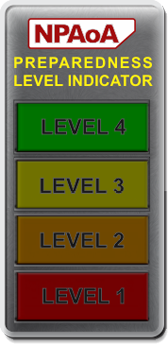Training
The next generation of Situational Awareness and Readiness for Crisis (SARC) training will be coming in June 2011 and will concentrate on the five "S" of survival.
The courses are designed to teach how to recognize a coming crisis before it happens, prepare for the crisis, safely survive the crisis and flourish after the crisis has passed. The courses cover topics that range from basic safety and survival to information storage and financial survival.
Strategy [Click Here to Expand]
All crisis survival begins with a strategy and includes recognizing a coming crisis, preplanning and preparation
Planning - To successfully survive a crisis and to be prepared to rebuild after it passes a plan for each type of expected crisis must be completed. The plan would included what to bring, where to go, what will trigger the plan and who to include.
Financial - A major component of crisis survival and reconstruction is a financial plan. What to do with your money, what will be valuable during and after a crisis and how much is needed are some of the questions that must be answered.
Information - Two major categories of information exists:
- Current information, and
- Information that will be used during a crisis.
It is important to know which type is necessary when, where to get reliable information and how to store it for easy access.
Safety [Click Here to Expand]
During a crisis safety is paramount and includes the use of force, dealing with groups, and medical issues.
Camouflage - An important part of safety is to not be noticed.
Force - Physical and non-physical as well as lethal and non-lethal are just some of the types of force that can be employed to protect you and your family.
Groups - Safety can be found in numbers. Knowing what type of groups form during a crisis and how they will react can save your life.
Medical - The issue can range from what medicines that you need on a daily basis to how to treat an injury or illness during a crisis.
Shelter [Click Here to Expand]
To survive a crisis, shelter from weather, danger and disease must be found or created.
Type - The type of shelter varies according to situation, what is available and whether it is to be permanent or temporary.
Areas - Each area provides unique advantages and disadvantages to finding or constructing a shelter. Knowing what is available and where safety can be found is necessary for each area you will be in during a crisis.
Protection - For a shelter to be effective it must protect you from outside threats which include weather, people and disease.
Sustenance [Click Here to Expand]
Food and water is a major concern during any crisis.
Food - What to eat, where to find it, storage, preparation and nutrition are some of the many areas of knowledge needed for survival.
Water - How to find, store, reclaim and determine the safety of water will mean the difference between life and death in a crisis situation.
Sustainability [Click Here to Expand]
Sufficient resources must be available to survive the crisis to completion and rebuild in the aftermath.

